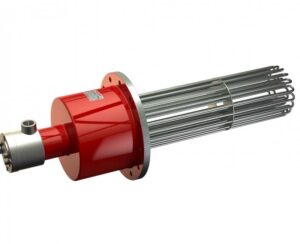Heating Bitumen
Bitumen and Electric Heating Elements
 Anyone with experience in the petrochemicals industry understands the need for and value of an appropriate electrical heating unit that meets their specific application’s needs. There is a broad range of electric heating elements on the market today, but the full context in which the item is to be used should be given full consideration before making a purchasing decision. Here you will find an in-depth explanation and examples of appropriate applications of many electric heating choices available to consumers.
Anyone with experience in the petrochemicals industry understands the need for and value of an appropriate electrical heating unit that meets their specific application’s needs. There is a broad range of electric heating elements on the market today, but the full context in which the item is to be used should be given full consideration before making a purchasing decision. Here you will find an in-depth explanation and examples of appropriate applications of many electric heating choices available to consumers.
Many different types of electric heaters are available, some of which have broader applications and others that have very specific applications. Electric heating can be simply defined as any process in which electrical energy is converted to heat. The broad categories of electric heaters we will be exploring include flanged heaters, immersion heaters and circulation heaters.
Flange Heaters
If you do not first understand what a flange is, you can’t visualize what a flange heater is because its design is based on the structure that the name describes. A flange can be defined as a lip or a rim on an object that is used to strengthen or hold the object fast. An example of a flange found in everyday life is lip along the lens mount of a camera, which holds the lens fast to the camera body.
A flange heater, therefore, is characterized as such by having one or more flanges, or rims that extend down into the item you are seeking to heat. They can often appear like a stick or bundle of sticks extending down from the connection point. Or, they can appear as a “U” stretched vertically, which is an excellent design as it significantly increases the surface space for the electrical heat to be applied to the substance.
Immersion Heaters
Immersion heaters do just as one would expect by their name: heat an item or substance by being immersed in it. A perfect example of an immersion heater is found in most water heaters. An immersion heating unit can be found affixed at the top of the hot water cylinder. In this example, the liquid is heated when it passes over the heating unit, suspended into the tank.
One common disadvantage of an immersion heater, specifically when heating water, is that the water that passes near the electric element gets so hot that it forms a scale buildup in areas with hard water. Over time, this scale builds up in the tank, leading to a less efficient heating system.
It should be noted, too, that one of the most common types of flange heaters is an immersion flange heater. This type of heater combines the two greatest strengths, which is the increased heating surface of the flange combined with the fast heating properties of an immersion heater since it is immersed within the product it seeks to heat.
Circulation Heaters
Circulation heaters are a closed system in which the item to be heated is passed throughout the heater in high-strength tubes and is exposed to heat from the outside of the tube. The substance exits the system at the pre-set temperature. Circulation heaters are generally used on pressurized substances such as gas, steam, oil, or other pressurized liquid or gas.
The main advantage of a circulation heater is that the heat loss during the process is extremely minimal since the system is closed, making it a highly efficient process. It is also a more exact heating process because of the way the system works, which can be critical with certain types of liquids and gasses.
Top-end circulation heaters are often housed within a well-built, well-insulated steel tank or vessel. The degree to which the space between the tubes is insulated determines the heat transfer rate, which is to say that the level of insulation minimizes heat loss and determines the efficiency of the heater overall.
Applications of Electric Heaters
 When people consider these types of electric heaters, they automatically think about applications where the element is used to warm liquids and gasses. Certainly heating fluids and gasses directly either within a tank or inside a pressure vessel is seen most often. Another excellent application for these types of electric heaters that is seen in industry but not commonly discussed is that they are used not specifically to heat liquids and gasses, but rather to prevent them from freezing.
When people consider these types of electric heaters, they automatically think about applications where the element is used to warm liquids and gasses. Certainly heating fluids and gasses directly either within a tank or inside a pressure vessel is seen most often. Another excellent application for these types of electric heaters that is seen in industry but not commonly discussed is that they are used not specifically to heat liquids and gasses, but rather to prevent them from freezing.
Along the same lines, these types of electric heaters can be utilized in aircraft propellers to prevent freezing. Having ice build up on a plane’s propellers is a huge risk that can be easily be avoided and addressed using a small electric heater.
Specific to the petrochemical industry, one method of removing sand particles from crude oil can be made more efficient with the use of electric heating. In another similar application, a copper powder is used as a conducting medium for the electric heater in removing sand from heavy oil on site for offshore platforms.
Materials Used for Bitumen Heating
The most common material used in these electric heating elements is steel. It is most compatible and cost effective when working with lubricants, heavy oils, light oils, certain types of gasses, waxes and mildly corrosive fluids. Using steel for the heater is advantageous because it is resistant to corrosion, has an impressive and extended life and minimizes heat loss from the material inside.
Stainless steel is also a growing trend in the industry and has its own series of appropriate applications. As seen in industrial kitchens, stainless steel is most commonly used in applications that affect or support the food service industry. Stainless steel is also a great material to be used in situations where the contents of the element will be housing mildly to severely corrosive fluids and gasses.
Importance of Precision for Bitumen Heating
Selecting the appropriate heater for the specific application is of absolute importance and relies on the application’s requirements before you begin to consider heaters. Because electric heaters can be used in applications and solutions as basic as water or soap storage to heating volatile liquids and corrosive solutions as well as superheating steam, the criticality of knowing exactly what is needed from the product before selecting one can’t be stated strongly enough.
In these situations, regulating a very precise temperature and heat distribution is critical and, with electric heating elements, attainable. The electric heating processes used in each type of element is considered to be clean for heat, is very quiet and does not radiate heat byproduct into the surroundings. As is needed in many industrial or commercial applications, electrical heating elements are highly responsive and can contribute well to mass production equipment and situations.
When considering electric heating elements, conduct ample research to ensure that you have chosen the right product for your specific application. This additional time and attention can be what helps you to find the most appropriate, safe, and cost-effective as well as energy-efficient product to fit your needs.
